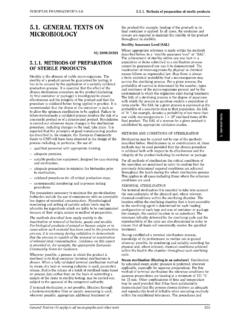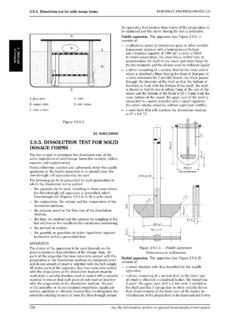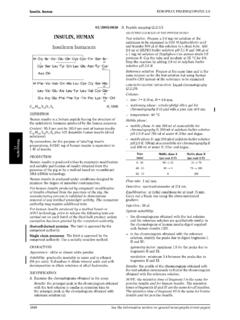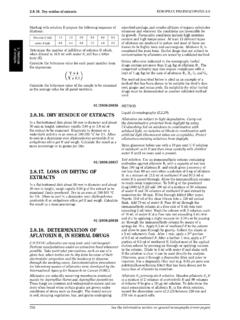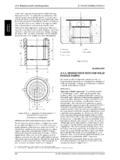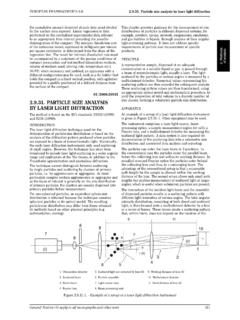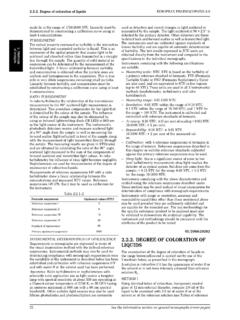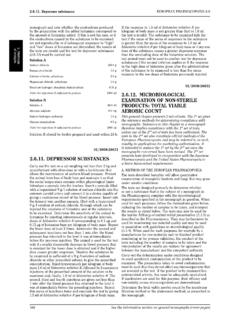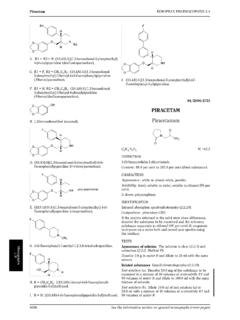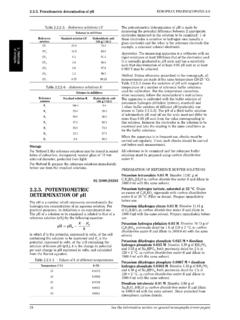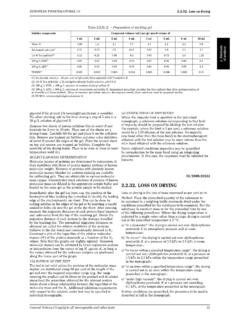Transcription of 2.5.32. WATER: MICRO DETERMINATION 2.5.30 ... - …
1 european pharmacopoeia Water: MICRO determinationcent V/V) M sodium hydroxideuntil a violet-bluecolour is obtained, without exceeding the end-point. Placethe solution in the test-tube (D). Without interruptingthe stream of carbon dioxide, remove the funnel (B)andintroduce through the opening into the flask (A) substance to be examined (mg) with the aid of 100 ml ofwater R. Add through the funnel 80 ml ofdilute hydrochloricacid Rand boil for 1 h. Open the tap of the funnel and stopthe flow of carbon dioxide and also the heating and thecooling water. Transfer the contents of the test-tube withthe aid of a littlewater Rto a 200 ml wide-necked, conicalflask.
2 Heat on a water-bath for 15 min and allow to cool. blue Rinalcohol(20 per cent V/V) Rand titrate M sodium hydroxideuntil the colour changes from yellow to violet-blue (V1ml).Carry out a blank titration (V2ml).Calculate the content of sulphur dioxide in parts per millionfrom the expression:n=molarity of the sodium hydroxide solution usedas Apparatus for the DETERMINATION ofsulphur dioxide01/2008 OXIDISING SUBSTANCEST ransfer g to a glass-stoppered, 125 ml conical flask andadd ml ofwater R. Insert the stopper and swirl for 5 to a glass-stoppered 50 ml centrifuge tube andcentrifuge. Transfer ml of the clear supernatant liquidto a glass-stoppered 125 ml conical flask.
3 Add 1 ml ofglacialacetic acid Rand g to g ofpotassium iodide stopper, swirl, and allow to stand for 25 min to 30 minin the dark. Add 1 ml ofstarch solution Rand titrate M sodium thiosulphateuntil the starch-iodine colourdisappears. Carry out a blank DETERMINATION . Not more ml M sodium thiosulphateis required ( percent, calculated as H2O2). M sodium thiosulphateis equivalent to 34 gof oxidising substances, calculated as hydrogen RIBOSE IN POLYSACCHARIDEVACCINESTest solution. Use a volumetric flask with a suitable volumefor preparation of a solution containing about 5 mg permillilitre of dry polysaccharide. Transfer the contents of acontainer quantitatively to the flask and dilute to volumewithwater R.
4 Dilute the solution so that the volumes used gto25 ml of the diluted solution into tubes in solutions. Dissolve 25 mg ofribose Rinwater (stocksolutioncontaining g/l of ribose). Immediately before use, dilute1 ml of the stock solution to ml withwater R(workingdilution:25mg/lofribose). , , ml, ml, ml and ml of the working dilutioninto 6 a blank using 2 ml ofwater up the volume in each tube to 2 ml withwater Add 2 ml of a g/l solution offerric chloride Rinhydrochloric acid g/l solution oforcinol Rinethanol a water-bath for 20 min. Cool in iced water. Measure theabsorbance ( ) of each solution at 670 nm using theblank as the compensation liquid.
5 Draw a calibration curvefromtheabsorbancereadingsforthe6ref erencesolutionsandthecorrespondingconten tofriboseandreadfromthecurve the quantity of ribose in the test solution for eachvolume tested. Calculate the mean of the 3 WATER: MICRODETERMINATIONPRINCIPLEThe coulometric titration of water is based upon thequantitative reaction of water with sulphur dioxide andiodine in an anhydrous medium in the presence of a base withsufficient buffering capacity. In contrast to the volumetricmethod described under ( ), iodine is producedelectrochemically in the reaction cell by oxidation of the water and the sulphur dioxide contained in thereaction cell.
6 The amount of water in the substance isdirectly proportional to the quantity of electricity up untilthe titration end-point. When all of the water in the cell hasbeen consumed, the end-point is reached and thus an excessof iodine appears. 1 mole of iodine corresponds to 1 moleof water, a quantity of electricity of C corresponds is eliminated from the system by determinations can be carried out successively inthe same reagent solution, under the following conditions:GeneralNotices(1) Total proteinEUROPEAN pharmacopoeia each component of the test mixture is compatible withthe other components, no other reactions take place, the volume and the water capacity of the electrolytereagent are titration is restricted to the quantitativedetermination of small amounts of water, a range of 10 gup to 10 mg of water is and precision of the method are predominantlygoverned by the extent to which atmospheric moisture isexcluded from the system.
7 Control of the system must bemonitored by measuring the amount of baseline apparatus consists of a reaction cell, electrodesand magnetic stirrer. The reaction cell consists ofa large anode compartment and a smaller cathodecompartment. Depending on the design of the electrode,both compartments can be separated by a diaphragm. Eachcompartment contains a platinum electrode. Liquid orsolubilised samples are introduced through a septum, usinga syringe. Alternatively, an evaporation technique may beused in which the sample is heated in a tube (oven) and thewater is evaporated and carried into the cell by means of astream of dry inert gas.
8 The introduction of solid samplesinto the cell should in general be avoided. However, if it hasto be done it is effected through a sealable port; appropriateprecautions must be taken to avoid the introduction ofmoisture from air, such as working in a glove box in anatmosphere of dry inert gas. The analytical procedure iscontrolled by a suitable electronic device, which also displaysthe the compartments of the reaction cell withelectrolytereagent for the MICRO DETERMINATION of water Raccordingto the manufacturer s instructions and perform thecoulometric titration to a stable end-point. Introduce theprescribed amount of the substance to be examined into thereaction cell, stir for 30 s, if not otherwise indicated in themonograph, and titrate again to a stable end-point.
9 In casean oven is used, the prescribed sample amount is introducedinto the tube and heated. After evaporation of the waterfrom the sample into the titration cell, the titration is the value from the instrument s output and calculate ifnecessary the percentage or amount of water that is presentin the substance. When appropriate to the type of sampleand the sample preparation, perform a blank OF THE ACCURACYB etween two successive sample titrations, introduce anaccurately weighed amount of water in the same order ofmagnitude as the amount of water in the sample, either aswater Ror in the form ofstandard solution for the microdetermination of water R, and perform the coulometrictitration.
10 The recovery rate is within the range from percent to per cent for an addition of 1000 g of H2 Oand in the range from per cent to per cent forthe addition of 100 g of :20533corrected TOTAL PROTEINMany of the assay methods described in this chapter can beperformed using kits from commercial 1 Protein in solution absorbs ultraviolet light at a wavelengthof 280 nm, due to the presence of aromatic amino acids,mainly tyrosine and tryptophan, in the protein structure. Thisproperty can be used for assay purposes. If the buffer used todissolvetheproteinhasahighabsorbancere lativetothatofwater, an interfering substance is present.
